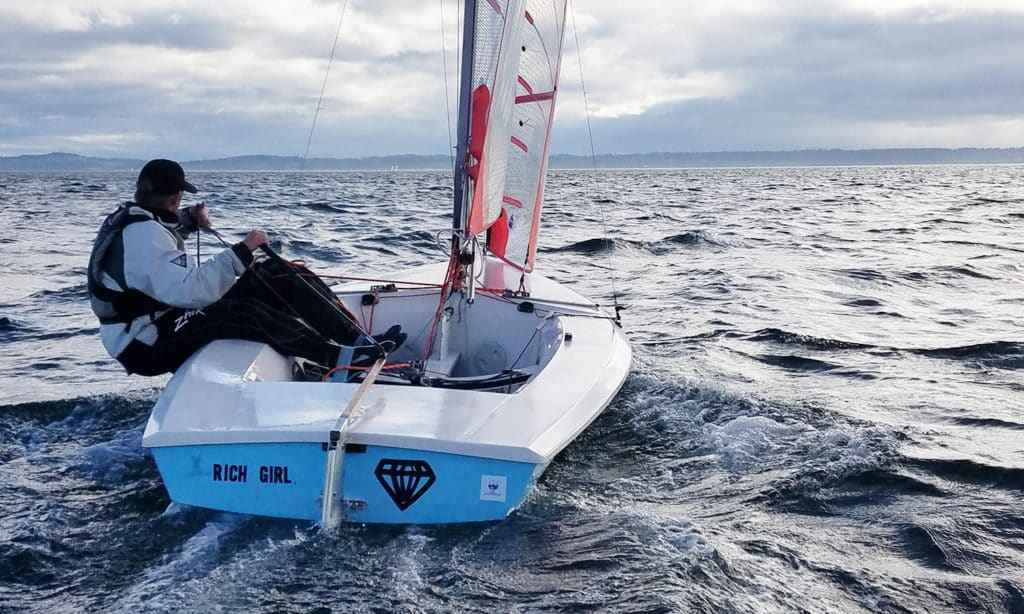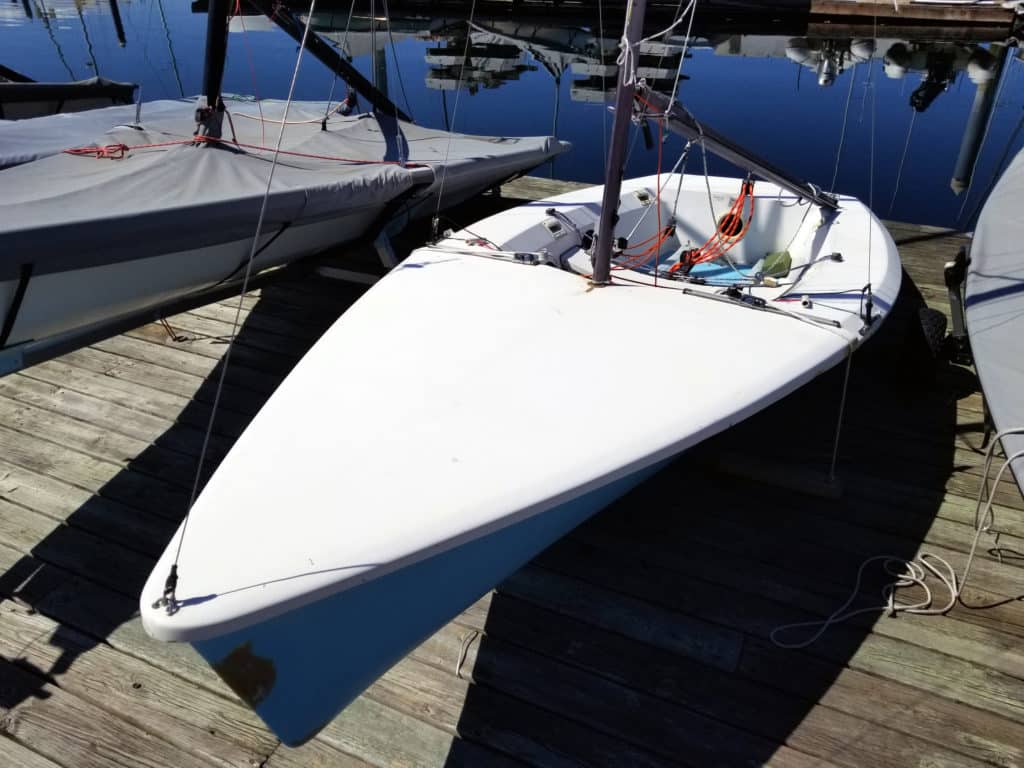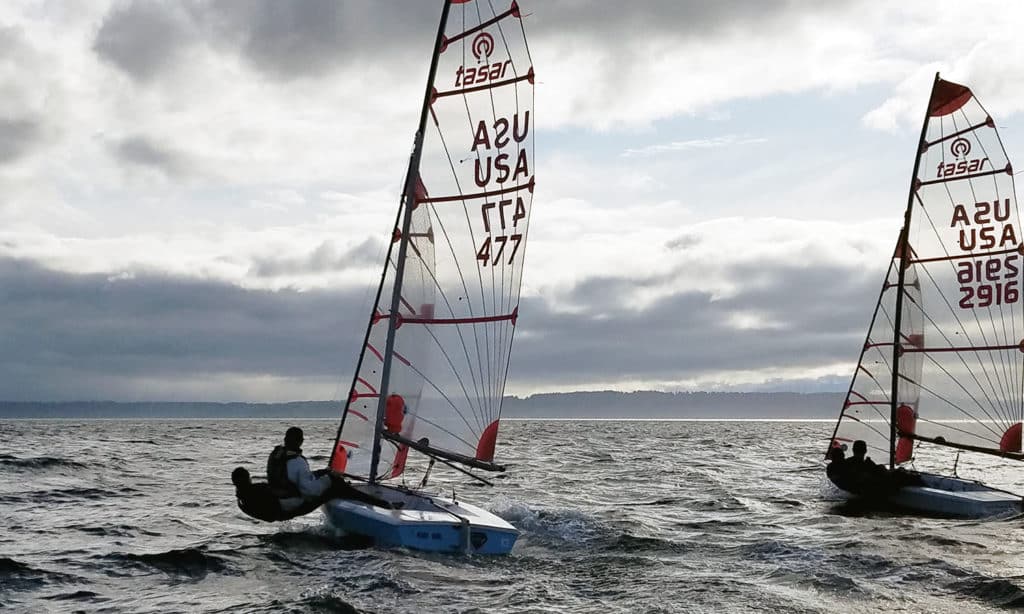
As I flew home from Cape Town after the TP52 Super Series a few months ago, I had a feeling the future might be different. A lot different. The Coronavirus was starting to really erupt, and suddenly the world I knew; travelling to regattas, sailing cool boats, dinners with friends old and new, all seemed at risk.
When I got home to Seattle it all started to really sink in: there might not be another regatta for a while. For someone who lives to race sailboats, this was a startling and disturbing thought. When I stopped feeling sorry for myself for a minute, I realized I was going to be fine, and there were many millions of people with far more serious issues than mine. I had temporarily lost my livelihood, both my sailing and my real estate development work, but others had lost their jobs, lost their business, lost their friend or loved one. Still, the pain was real, and I knew I needed some sort of remedy. Initially, I stayed busy by finishing a room in our basement, chipping away at chores and home projects. But what sort of sailing could I do? Obviously, a crewed boat was out of the question, unless…Then, a moment of inspiration: what if the crew was my wife? We needed a Tasar, and right away!
The Tasar was designed by Frank Bethwaite and Ian Bruce in the early 1970s as a boat for couples. No trapeze, no spinnaker, but a very light (150 pounds) and sophisticated doublehanded boat (think rotating mast). The class took off in Australia, where 50 years later it is still one of the most popular dinghies. Strong fleets eventually developed in Japan and England, and also in the Pacific Northwest, where good fleets grew in Seattle, Portland and Vancouver.
My wife, Libby, and I had one of our first dates at the 1986 Tasar U.S. Nationals, although she did not know it was a date at the time. We bought a used boat together shortly thereafter, even before we were married, and have had a Tasar ever since. We raced our first boat, No. 492, in the Tasar Worlds in 1987, in Vancouver, only to be beaten by my brother Charlie and his wife Becky (their third world title). We bought a new boat (No. 2597) in 1994, and won the Worlds in 1996 and 2003 with that boat. We also won the Worlds in 2007 and 2017 in chartered boats. We had that Tasar for 25 years, it was like a part of our family, but we finally sold it last winter to buy a new boat. This seemed like a good plan until we got news that the new boat was delayed because of shipping issues from the factory in Indonesia.
This was where I found myself upon returning from South Africa; no regattas to sail, itching to get on the water, but no Tasar to sail either. I started asking around about borrowing a boat, and our fleet captain mentioned there was an old Tasar owned by the Seattle fleet that “needed some work.”
I should have thought “can of worms,” but I was drunk with the idea of sailing this boat. She is Hull No. 477, even older than our original boat, 492, and named “Rich Girl” for some obscure reason. Possibly tongue in cheek. I asked if I could take it on, in return for using it until our new Tasar arrived, and he agreed.
I picked up the boat and its assorted parts from his house and drove it all home. On initial inspection it looked tired, but serviceable. Through my rose-colored glasses I missed some of the shortcomings, like the lack of a rudder, a bent mast, beat up sails, rotted plywood backing plates, etc. I was just psyched to have a project, and one that would eventually get us sailing. As I got into it, I realized I needed to do this without the normal access to the marine store, so I had to find the supplies and parts in other ways. Beg, steal or borrow.
I started the project by flipping the hull over in my front yard, and got to work with epoxy and Bondo. My neighbors were a little curious, and the masked passers-by on the sidewalk gave me some strange looks.

“That is a funny looking fishing boat,” someone opined. A few passing dogs barked at it.
I started filling in the bigger dents in the bottom and faired out some previous repairs. I also re-faired the daggerboard trunk, which is now legal in the Tasar class. It was strangely peaceful work, so unconnected to what was going on all around me. It calmed me and led my brain to fantasize about sailing again. There were times when it was so quiet I forgot I was in the middle of a big city. The birds were singing. I could hear little bits of conversations of neighbors. There were no cars, no laughing schoolchildren in the playground down the street, few jets flying overhead.
Work on the Tasar bottom required me to turn the boat on its side, so I used the boxwood hedge that separates my front yard from the sidewalk as a prop. The Tasar is so light, it was quite easy to flip it back it and forth, and thus I could do all my work myself, in my own little world. The boxwood took a bit of a beating, but small price to pay for a fair bottom, right?
When I finished with the bottom and centerboard trunk, I decided I should probably fair the centerboard, as it was pretty beat up. So that took another day. I sanded the skin off my fingertips and had to start wearing gloves and a mask. Hey, wait a minute. Now I was really in lockdown mode: gloves, N95 mask, staying away from everyone. Doing my part.
At this point, I discovered the mast was bent, in both dimensions. I tried to straighten it using my concrete steps and my body weight, but it wasn’t enough force. So, I asked Libby to help, and we eventually got it straight enough through carefully calibrated bouncing. We flipped the boat upright, put up the mast (watch out for that tree branch), measured the mast rake and it was right on. So now we had a serviceable rig.
The sails were not good. Our local Tasar dealer, West Coast Sailing, made me a good deal on a new suit and were able to ship them to our house, a $1,600 investment. But, we all know we need good sails, so it was totally worth it. I forgot to order sail numbers, but I do have a few felt pens.
The rudder and tiller were completely missing. I sent out a note on our fleet list-serv, and it turns out my friend Jay had a broken rudder and old-style rudder head he was willing to donate to the cause. The blade was completely split down the middle.
Could I fix it? I decided to give it a try because a new rudder would be expensive. So, I glued it back together and added some epoxy/S Glass reinforcement to the top. Now I had a decent rudder, if it didn’t break. I had an old wood tiller that I pressed into service. I replaced the running rigging with bits of old rope I had lying around the house. This was like a return to my childhood, when I used to collect old bits of rope lying around the boatyard.
After a week of front-yard yacht repair, we were ready to go sailing. The next day was Saturday, so we announced our plan to try to sail and two other Tasar teams decided to join us. It was a stunning day, bright sunshine and a perfect 12-knot northerly. We arrived at the launch ramp with mask on, but very few other boaters were around. The sail went brilliantly, and of course, we were a little out of our prime hiking form, but the sheer joy of sailing this beautiful (on the inside) boat, on the incredible Puget Sound, with my lovely and talented wife…
It is hard to describe the feeling of momentary normalcy, that the activity that gives us so much joy can still deliver, even in these crazy times. And the boat did pretty well. We were not slow, upwind or down, and most aspects of the boat were working fine. We finished the day with a page-long work list, but I was feeling better than I had for weeks. We left the boat on the floating dock where we store dinghies at Shilshole, ready for next time. More sailing in our future.
That first sail made clear that the transom was really mushy. Upon closer inspection, the plywood backing plate for the gudgeons was completely rotted. I made another sojourn to Shilshole with more tools and epoxy. I dug out the old rot which was originally the backing plate as well as I could, considering the limited access to the aft tank. I glued in a new backing plate made from an old batten, and re-installed the lower gudgeon. Now we had decent steering.
I also noticed the jib tracks had been put in with wood screws. It appears that this had worked for the last 43 years, but the screws were now stripped and not holding, and the tracks were leaking water into the hull, so I added a few bolts, tightened it down, and called it good. Then, I added a new cunningham cleat to the base of the mast, which is now class legal, to make it easier to adjust the cunno from hiking, a critical adjustment on the Tasar. I thought about changing the name, but then I remembered that this can bring bad luck to a boat, and this particular boat did not need any additional challenges.
Instead, I added a little bit to the name: “Rich Girl (but sweet!).”
We are lucky here in Seattle that it is still possible to go dinghy sailing. The marina at Shilshole where we sail is still open. The public has been asked to not congregate at parks or beaches, but we have also been told to “stay fit and active.”
I have decided that occasional sailing with my wife, as a means to staying fit (and sane) was allowed, and we were not putting anyone else at risk. As long as we kept our distance from others while rigging, and did not require any rescue (a serious consideration in our case), we should be alright.
It turns out some of our Tasar friends have a similar desire to stay fit, and we sometimes turn up on the water at the same time. Everyone is taking extra precautions to stay safe and keep away from others, but we have been able to do some great sailing. The weather has been incredible; wind almost every day, and lots of sunny northerlies. Thus far, we’ve had “Rich Girl” out for a run six times. No breakdowns yet! And she is going alright, especially up-range, which has always been our specialty. It’s amazing that a 43-year-old boat can be brought back from the dead, and provide just as much joy as a brand new one. Maybe more, because a little bit of our heart and soul are invested in it.
One challenge has been sailing with our friends, but not interacting with them before and after. We have established an email debrief system that is working well from a technical standpoint. We used to socialize before and after sailing, standing around the boats or at the club bar, but that is obviously not happening and we really miss it. Recently, after we came in from sailing, we went over to the launching ramp to say goodbye to our friends as they packed up their boats. These are friends we have had for 30 years or more—we went to each other’s weddings, and know what each other’s kids are up to. As we drove up, I rolled down the window. Libby started to get out of the car, then stopped herself. We had a little chat out the window, then said goodbye. I think I saw a tear falling down Libby’s cheek as we slowly drove home. Yes, we had the wonderful gift of going sailing together. But so much is missing, even if I try to pretend otherwise.

I am calling the project a success. I found a diversion from the world. I am in the best shape I have been in years. I am staying sharp, remembering how to catch waves and roll tack, how to read the wind.
As I write, I just got word our new Tasar finally shipped and is due to arrive in the States next month. Thus, our days with Tasar 477 are coming to an end, but it will be a great boat for the Seattle fleet to use to introduce new people to the Tasar, as it was always intended to be. And I will always be grateful to have had this project, one of the silver linings we all need to keep us positive in this time of great sadness and uncertainty.









